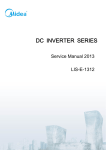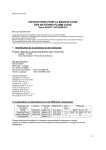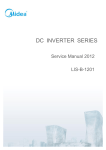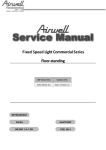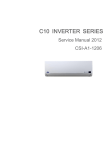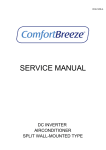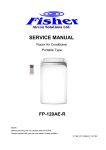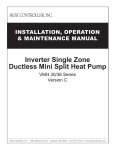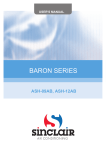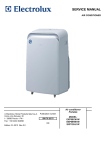Download SERVICE MANUAL
Transcript
SERVICE MANUAL AIRCONDITIONER FLOOR STANDING TYPE Model: MFGA-60ARDN1-QC2 CONTENTS 1. Safety Precautions .............................................................................................................. 1 1.1 Precaution.............................................................................................................................. 1 1.2 Installation.............................................................................................................................. 1 1.3 Caution .................................................................................................................................. 1 1.4 Operational ............................................................................................................................ 2 2. Dimension ............................................................................................................................ 3 2.1 Indoor Unit .................................................................................................................................. 3 2.2 Outdoor Unit ............................................................................................................................... 4 3. Refrigerant cycle diagram .................................................................................................. 5 4 . Wiring diagram ........................................................................................................................ 6 5. .Installation details ................................................................................................................... 7 5.1 Installation place ......................................................................................................................... 7 5.2 Installing ..................................................................................................................................... 8 5.3 Refrigerant pipe connection ..................................................................................................... 10 5.3.3 Installation for the first time ................................................................................................... 15 5.3.4 Adding the refrigerant after running the system for many years ........................................... 20 5.3.5 Re-installation while the indoor unit need to be repaired ...................................................... 22 5.3.6 Re-installation while the outdoor unit need to be repaired.................................................... 25 5.4 Drain Pipe of The Indoor Unit ................................................................................................... 28 5.5 Wiring ....................................................................................................................................... 28 5.6 TEST RUN ................................................................................................................................ 28 6. .External view and display .................................................................................................... 30 6.1 External view ............................................................................................................................ 30 6.2 CONTROL PANEL ................................................................................................................... 31 7.Operation characteristics ....................................................................................................... 31 8.Electronic function .................................................................................................................. 32 8.1 Main data Introduction ......................................................................................................... 32 8.2 Operation Modes and Functions ......................................................................................... 32 8.3 Other Functions ................................................................................................................... 37 9.Characteristic of temperature sensor ................................................................................... 38 10.Trouble shooting ................................................................................................................... 38 10.1 Protective Function ........................................................................................................... 38 10.2 Self-diagnosis .................................................................................................................... 40 10.3 Troubles and Solutions..................................................................................................... 40 1. Safety Precautions 1.1 Precaution To prevent injury to the user or other people and property damage, the following instructions must be followed. Incorrect operation due to ignoring instruction will cause harm or damage. Before service unit, be sure to read this service manual at first. 1.2 Installation For electrical work, contact the dealer, seller, a qualified electrician, or an Authorized service center. Do not disassemble or repair the product by yourself. Sharp edges could cause injury, be especially careful of the case edges and the fins on the condenser and evaporator. Be sure the installation area does not deteriorate with age. Take care to ensure that power cable could not be pulled out or damaged during operation. Do not place anything on the power cable. Do not plug or unplug the power supply plug during operation. Do not store or use flammable gas or combustible near the product. When flammable gas leaks, turn off the gas and open a window for ventilation before turn the product on. If strange sounds, or small or smoke comes from product. Turn the breaker off or disconnect the power supply cable as soon as possible. When the product is soaked (flooded or submerged), contact an Authorized service center. Be caution that water could not enter the product. Turn the main power off when cleaning or maintaining the product. When the product is not be used for a long time, disconnect the power supply plug or turn off the breaker. 1.3 Caution Always check for gas (refrigerant) leakage after installation or repair of product. Install the drain hose to ensure that water is drained away properly. Keep level even when installing the product. Do not install the product where the noise or hot air from the outdoor unit could damage the neighborhoods. Use two or more people to lift and transport the product. Do not install the product where it will be exposed to sea wind (salt spray) directly. 1 1.4 Operational Do not expose the skin directly to cool air for long periods of time. (Do not sit in the draft). Do not use the product for special purposes, such as preserving foods, works of art, etc. It is a consumer air conditioner, not a precision refrigerant system. Do not block the inlet or outlet of air flow. Use a soft cloth to clean. Do not use harsh detergents, solvents, etc. Do not touch the metal parts of the product when removing the air filter. They are very sharp. Do not step on pr put anything on the product. (outdoor units) Always insert the filter securely. Clean the filter every two weeks or more often if necessary. Do not insert hands or other object through air inlet or outlet while the product is operated. Do not drink the water drained from the product. Use a firm stool or ladder when cleaning or maintaining the product. Replace the all batteries in the remote control with new ones of the same type. Do not mix old and mew batteries or different types of batteries. Do not recharge or disassemble the batteries. Do not dispose of batteries in a fire. If the liquid from the batteries gets onto your skin or clothes, wash it well with clean water. Do not use the remote of the batteries have leaked. 2 2. Dimension 2.1 Indoor Unit Dimension Mode MFGA-60ARDN1-QC2 W(mm) D(mm) H(mm) 610 390 1925 3 2.2 Outdoor Unit MODEL A B C D E F H MOU-60HDN1-R 940 600 376 400 340 360 1245 4 3. Refrigerant cycle diagram INDOOR OUTDOOR Electronic Expansion Valve LIQUID SIDE 2-WAY VALVE CAPILIARY TUBE HEAT EXCHANGE (EVAPORATOR) HEAT EXCHANGE (CONDENSER) GAS SIDE REVERSING VALVE 3-WAY VALVE ACCUMULATOR COOLING COMPRESSOR 5 HEATING 4 . Wiring diagram MFGA-60ARDN1-QC2 Indoor Unit Outdoor Unit 6 5. .Installation details 5.1 Installation place 5.1.1 Indoor Unit a. A place which provides the spaces around the indoor unit as required above in the diagram. b. A place where is no obstacle near the inlet and outlet area. c. A place which can bear the weight of the indoor unit. d. A place which allows the air filter to be removed downward. e. A place where the reception range is not exposed to direct sunlight. f. In the center of the room where possible. 5.1.1.1 Please stand the unit in hard and flat ground; Please reserve space for installation and maintenance. 5.1.1.2 Please check the elevation difference between the indoor unit and the outdoor unit, the length of the refrigerant pipe, and the curved places (bend) of the pipe are no more than the following numbers: Elevation difference: no more than 10M (if the elevation difference between indoor and outdoor unit is more than 10 meters, it is recommended that the indoor unit be located higher than the outdoor unit.) Pipe length: no more than 20M. Bends: no more than 3 places. 5.1.2 Outdoor Unit 5.1.2.1 Before installing the outdoor unit, you should: a). Select a place where no direct sunlight or other heat-radioactivity may reach. A sunshade is needed if it is unavoidable. b). Select a place that is easy to connect indoor unit's pipe and electric wires. c). Avoid a place where combustible gas may leak or stay. d). Keep it in mind that water may drain out of the outdoor unit while in "Heat" mode. Caution: Installation in the following places may cause trouble. If it is unavoidable to use in such places, please consult with the dealer. 7 a. A place full of machine oil. b. A saline place such as coast. c. Hot-spring resort. d. A place full of sulfide gas. e. A place where there are high frequency machines such as wireless installation, welding machine, medical facility. f. A place of special environmental conditions. 5.1.2.2 If the outdoor unit is to be installed on a roof or where no constructions are around, you should avoid hard wind blows directly to the air outlet, because it may cause trouble for air-flow shortage. 5.1.2.3 Reserve enough space for installation, maintenance and unit-functioning. Remove as many obstacles as possible nearby. 5.2 Installing 5.2.1 Indoor Unit: 1. Anti-falling; To prevent the indoor unit from falling, you must: a. Pay full attention to the unit because its long outer shape makes it easy to fall; b. Firmly fix the unit to the wall or in the ground to avoid accidental falling. 8 2. Dismounting the air-inlet grid Please take off the air-inlet grid before connecting the pipes/wires. Pull down the two knobs on the grid, take off the two screws, then the air-inlet grid goes free. 3. Take the Pipe Clip off before connecting the pipes and wiring; fit it when these finished. Use accessories to connect the pipes/wires on both sides and back side. 9 5.2.2 Outdoor Unit: 1. Ship the a/c to the installation place originally packed; 2. Be careful while hanging the unit because the center of gravity of the unit is not centralized; 3. Do not make the angle of inclination more than 45 degrees while shipping;(Avoid horizontal storage) 4. Be sure the electric insulation work is well done if installed on metal ceiling / wall. 5. Fix the unit feet with bolts (M10/M8). Be sure the unit is fixed strongly enough to against blast or earthquake. 6. Make a concrete basement to the unit by the following references. For the value of A and B, please refer to the dimension table. 5.3 Refrigerant pipe connection 5.3.1 Pipe length and the elevation The correct refrigerant quantity filled in the 5-meter-long pipe of the outdoor unit is marked on the Product Data Plate. If you have to use longer pipe for every meter plus pipe, the refrigerant should be added according to the following calculation. 10 Pipe size Standard Max. Max. Additional length Elevation Length refrigerant (m) B (m) A (m) (g/m) 5 15 30 40 Capacity Btu/h Gas Liquid 5/8’’ 3/8’’ (Ф16.0) (Ф9.52) MFGA-60ARDN1-QC2 Caution: Capacity is base on standard length and maximum allowance length is base of reliability. Oil trap should be installed per 5-7 meters. 5.3.2 Piping connection 5.3.2.1 Connecting Of Refrigerant Pipe a) Only the correctly installing of indoor and outdoor unit done, can the refrigerant pipe be connected. b) The cut-off valves are completely close before ex-work. Before connecting the refrigerant pipe, be careful to check whether the valves are completely close. c) The connecting procedure of refrigerant pipe: first, unscrew the two valves on the outdoor unit and the pipe-jointing nut on the indoor unit(please keep them care fully). Please connect the refrigerant pipe according to the manual, the pipe-jointing nut should be screw tightly and no leakage. Note: you need two wrenches to make balance. d) When the connecting of refrigerant pipe is finished, before power on the system, you 11 should vacuum the indoor unit through the maintenance port on the cut-off valves, or open the high-pressure valve, and exhaust the air through the maintenance port on the low-pressure valve(closed). It will take about ten seconds. Then screw tightly the maintenance port. (When supplement the refrigerant, fill through the maintenance port of the low-pressure valves on the outdoor unit ). e) Open all the valves completely before power on the system, or it will be sick for low efficiency. f) Gas leak check. Make sure no gas from connections with leak detector or soap water. Caution: A: Lo packed valve B: Hi packed valve C and D are ends of indoor unit connection. Caution in Handling the Packed Valve a. Open the valve stem until it hits against the stopper. Do not try to open it further. b. Securely tighten the valve stem cap with a spanner or the link. Notes for the bendable pipe a. The bendable pipe should be used on the indoor side; b. Bend angel may not exceed 90 degrees; c. The bend location should be made on the center of the pipe if possible, as for bend radius, the bigger the better; 12 d. The bendable pipe may not be bent for more than 3 times. Bend the thin pipe a. While bending, expose the pipe by cutting the concave gap on the bending heat-insulation pipe(roll it with soft band after bent). b. To avoid pipe deformation, the radius is the bigger the better. c. Use a pipe-bending device to make the compact bending pipe. 5.3.2.2 Using bronze pipe selling in market Completely shut the cut-off valves of the outdoor unit (as ex-work status). After the refrigerant pipe has been connected with both the indoor and outdoor unit, let the air exhaust out from the maintenance gap on he low-pressure cut-off valves of the outdoor unit. Screw the nuts tightly on the maintenance gap after the air has been drained. 5.3.2.3 To make the refrigerant pipe unblocked completely You should keep the cut-off valves of the outdoor unit completely open after you have finished the above steps (5.3.2.1 or 5.3.2.2) Note: 1.Before screwing the reamer nut, smear the pipe and the connecting surface with refrigerant oil; 2.Check and make sure there is no leakage by soap-water or leakage-checker after connecting; 3.Be sure the connecting joint on the indoor side is insulated. 4.Use two wrenches to connecting the pipes. 13 Additional Outside diameter Torque tightening torque mm inch N.cm N.cm Ф9.52 3/8 2500 2600 Ф12.7 1/2 3500 3600 Ф16 5/8 4500 4700 Ф19 3/4 6500 6700 14 5.3.3 Installation for the first time Air and moisture in the refrigerant system have undesirable effects as below: ● ● ● ● ● Pressure in the system rises. Operating current rises. Cooling or heating efficiency drops. Moisture in the refrigerant circuit may freeze and block capillary tubing. Water may lead to corrosion of parts in the refrigerant system. Therefore, the indoor units and the pipes between indoor and outdoor units must be leak tested and evacuated to remove gas and moisture from the system. Gas leak check (Soap water method): Apply soap water or a liquid neutral detergent on the indoor unit connections or outdoor unit connections by a soft brush to check for leakage of the connecting points of the piping. If bubbles come out, the pipes have leakage. 1. Air purging with vacuum pump (Indoor unit) (Outdoor unit) (Liquid side) Two-way valve Close (Gas side) Three-way valve Manifold valve Compound meter Pressure gauge 20Pa Lo Handle Lo Charge hose Close Hi Handle Hi Charge hose Vacuum pump Vacuum pump 1) Completely tighten the flare nuts of the indoor and outdoor units, confirm that both the 15 2-way and 3-way valves are set to the closed position 2) Connect the charge hose with the push pin of handle lo to the 3-way valves gas service port.. 3) Connect the charge hose of handle hi connection to the vacuum pump. 4) Fully open the handle Lo of the manifold valve. 5) Operate the vacuum pump to evacuate. 6) Make evacuation for 30 minutes and check whether the compound meter indicates -0.1Mpa. If the meter does not indicate -0.1Mpa after pumping 30 minutes, it should be pumped 20 minutes more. If the pressure can’t achieve -0.1Mpa after pumping 50 minutes, please check if there are some leakage points. Fully close the handle Lo valve of the manifold valve and stop the operation of the vacuum pump. Confirm that the gauge needle does not move (approximately 5 minutes after turning off the vacuum pump). 7) Turn the flare nut of the 3-way valves about 45° counterclockwise for 6 or 7seconds after the gas coming out, then tighten the flare nut again. Make sure the pressure display in the pressure indicator is a little higher than the atmosphere pressure. Then remove the charge hose from the 3 way valve. 8) Fully open the 2 way valve and 3 way valve and securely tighten the cap of the 3 way valve. 2. Air purging by refrigerant 16 Procedure: 1). Confirm that both the 2-way and 3-way valves are set to the closed position. 2). Connect the charge set and a charging cylinder to the service port of the 3-way valve. 3). Air purging Open the valves on the charging cylinder and the charge set. Purge the air by loosening the flare nut on the 2-way valve approximately 45’ for 3 seconds then closing it for 1 minute; repeat 3 times. After purging the air, use a torque wrench to tighten the flare nut on the 2-way valve. 4). Check the gas leakage Check the flare connections for gas leakage. 5). Discharge the refrigerant Close the valve on the charging cylinder and discharge the refrigerant by loosening the flare nut on the 2-way valve approximately 45’ until the gauge indicates 0.3 to 0.5 Mpa. 6). Disconnect the charge set and the charging cylinder, and set the 2-way and 3-way valves to the open position. Be sure to use a hexagonal wrench to operate the valve stems. 7). Mount the valve stems nuts and the service port cap. Be sure to use a torque wrench to tighten the service port cap to a torque 18N·m. Be sure to check the gas leakage. 3. Adding the refrigerant if the pipe length >5m 17 Electronic scale Procedure: 1). Connect the charge hose to the charging cylinder, open the 2-way valve and the 3-way valve. Connect the charge hose which you disconnected from the vacuum pump to the valve at the bottom of the cylinder. If the refrigerant is R410A, make the cylinder bottom up to ensure the liquid charge. 2). Purge the air from the charge hose Open the valve at the bottom of the cylinder and press the check valve on the charge set to purge the air (be careful of the liquid refrigerant). 3) Put the charging cylinder onto the electronic scale and record the weight. 4) Operate the air conditioner at the cooling mode. 5) Open the valves (Low side) on the charge set and charge the system with liquid refrigerant. 6).When the electronic scale displays the proper weight (refer to the table), disconnect the 18 charge hose from the 3-way valve’s service port immediately and turn off the air conditioner before disconnecting the hose. 7). Mount the valve stem caps and the service port Use torque wrench to tighten the service port cap to a torque of 18N.m. Be sure to check for gas leakage. 19 5.3.4 Adding the refrigerant after running the system for many years Electronic scale Procedure: 1). Connect the charge hose to the 3-way service port, open the 2-way valve and the 3-way valve. Connect the charge hose to the valve at the bottom of the cylinder. If the refrigerant is R410A, make the cylinder bottom up to ensure liquid charge. 2). Purge the air from the charge hose Open the valve at the bottom of the cylinder and press the check valve on the charge set to purge the air (be careful of the liquid refrigerant). 3) Put the charging cylinder onto the electronic scale and record the weight. 4) Operate the air conditioner at the cooling mode. 5) Open the valves (Low side) on the charge set and charge the system with liquid refrigerant. 20 6).When the electronic scale displays the proper weight (refer to the gauge and the pressure of the low side), disconnect the charge hose from the 3-way valve’s service port immediately and turn off the air conditioner before disconnecting the hose. 7). Mount the valve stem caps and the service port Use torque wrench to tighten the service port cap to a torque of 18N.m. Be sure to check for gas leakage. 21 5.3.5 Re-installation while the indoor unit need to be repaired 1. Collecting the refrigerant into the outdoor unit Procedure 1). Confirm that both the 2-way and 3-way valves are set to the opened position. Remove the valve stem caps and confirm that the valve stems are in the opened position. Be sure to use a hexagonal wrench to operate the valve stems. 2). Connect the charge hose with the push pin of handle lo to the 3-way valves gas service port. 3). Air purging of the charge hose Open the handle Lo valve of the manifold valve slightly to purge air from the charge hose for 5 seconds and then close it quickly. 4). Set the 2-way valve to the close position. 5). Operate the air conditioner at the cooling cycle and stop it when the gauge indicates 0.1MPa. 22 6). Set the 3-way valve to the closed position immediately Do this quickly so that the gauge ends up indicating 0.3 to 0.5Mpa. Disconnect the charge set, and tighten the 2-way and 3-way valve’s stem nuts. Use a torque wrench to tighten the 3-way valves service port cap to a torque of 1.8 kgf.m. Be sure to check for gas leakage. 2. Air purging by the refrigerant Procedure: 1). Confirm that both the 2-way and 3-way valves are set to the closed position. 2). Connect the charge set and a charging cylinder to the service port of the 3-way valve. Leave the valve on the charging cylinder closed. 3). Air purging Open the valves on the charging cylinder and the charge set. Purge the air by loosening the flare nut on the 2-way valve approximately 45’ for 3 seconds then closing it for 1 minute; repeat 3 times. 23 After purging the air, use a torque wrench to tighten the flare nut on the 2-way valve. 4). Check the gas leakage Check the flare connections for gas leakage. 5). Discharge the refrigerant Close the valve on the charging cylinder and discharge the refrigerant by loosening the flare nut on the 2-way valve approximately 45’ until the gauge indicates 0.3 to 0.5 Mpa. 6). Disconnect the charge set and the charging cylinder, and set the 2-way and 3-way valves to the open position. Be sure to use a hexagonal wrench to operate the valve stems. 7). Mount the valve stems nuts and the service port cap. Be sure to use a torque wrench to tighten the service port cap to a torque 18N.m. Be sure to check the gas leakage. 24 5.3.6 Re-installation while the outdoor unit need to be repaired 1. Evacuation for the whole system Procedure: 1). Confirm that both the 2-way and 3-way valves are set to the opened position. 2). Connect the vacuum pump to 3-way valve’s service port. 3). Evacuation for approximately one hour Confirm that the compound meter indicates -0.1Mpa. 4). Close the valve (Low side) on the charge set, turn off the vacuum pump, and confirm that the gauge needle does not move (approximately 5 minutes after turning off the vacuum pump). 5). Disconnect the charge hose from the vacuum pump. 2. Refrigerant charging 25 Electronic scale Procedure: 1). Connect the charge hose to the charging cylinder, open the 2-way valve and the 3-way valve. Connect the charge hose which you disconnected from the vacuum pump to the valve at the bottom of the cylinder. If the refrigerant is R410A, make the cylinder bottom up to ensure liquid charge. 2). Purge the air from the charge hose Open the valve at the bottom of the cylinder and press the check valve on the charge set to purge the air (be careful of the liquid refrigerant). 3) Put the charging cylinder onto the electronic scale and record the weight. 4). Open the valves (Low side) on the charge set and charge the system with liquid refrigerant. If the system cannot be charge with the specified amount of refrigerant, or can be charged with a little at a time (approximately 150g each time) , operating the air conditioner in the 26 cooling cycle; however, one time is not sufficient, wait approximately 1 minute and then repeat the procedure. 5).When the electronic scale displays the proper weight, disconnect the charge hose from the 3-way valve’s service port immediately. If the system has been charged with liquid refrigerant while operating the air conditioner, turn off the air conditioner before disconnecting the hose. 6). Mounted the valve stem caps and the service port Use torque wrench to tighten the service port cap to a torque of 18N.m. Be sure to check for gas leakage. 27 5.4 Drain Pipe of The Indoor Unit 1. Make sure the drain pipe is connected to the outdoor side downward; 2.The hard polyvinyl chloride(PVC)plastic pipe (external diameter 26 mm) sold is the market is suitable for the attached soft drain pipe; 3.Please connect the Soft Drain Pipe with the Drain Pipe, then fix it with band; 4.If you have to connect the Drain Pipe indoors, to avoid condensing caused by air intake, you must cover the pipe with heat-insulation material (polyethylene with Specific Gravity of 0.03, at least 9 mm in thickness), and use Glue Band to fix it. 5.After the Drain Pipe has been connected, please check if the water drains out of the pipe efficiently and has no leakage. 6.Refrigerant pipe and Drainpipe should be heat-insulated to avoid condensing and water-dropping later on. 5.5 Wiring Please refer to the Wiring Diagram. Note: The power supply of the air conditioner is different according to the models. Please refer to the WIRING DIAGRAM pasted on the indoor and outdoor units before wire connection. 5.6 TEST RUN Perform test operation after completing gas leak and electrical safety check. The test operation time should last more than 30 minutes. 1. Open the panel and lift the panel up to angle which remains fixed. Do not lift the panel 28 any further when it stops with a "click" sound. 2. Press the manual switch button twice until the operation indicator lights, the unit will operate on Manual Cool mode. 3. Check if all the functions works well while testing the air conditioner. Especially check whether the drainage of indoor unit is smooth or not. 4. Press the manual switch button again till the operation indicator turns dark after finishing the test operation and the unit stops operation. 29 6. .External view and display 6.1 External view This unit consists of indoor unit and outdoor unit. Note: All the pictures in this manual are for explanation purpose only. They may be slightly different from the air conditioner you purchased (depend on model). The actual shape shall prevail. 30 6.2 CONTROL PANEL Control Buttons and Functions 7.Operation characteristics CAUTION: 1. If air conditioner is used outside of the above conditions, certain safety protection features may come into operation and cause the unit to function abnormally. 2. Room relative humidity less than 80%. If the air conditioner operates in excess of 31 this figure, the surface of the air conditioner may attract condensation. Please sets the vertical air flow louver to its maximum angle (vertically to the floor), and set HIGH fan mode. 3. Optimum performance will be achieved within this operating temperature. 8.Electronic function 8.1 Main data Introduction Ts : Set temperature, T1 : Room temperature T2: Evaporator coil temperature T3: Condenser coil temperature T4: Outdoor ambient temperature 8.2 Operation Modes and Functions 8.2.1Manual Operation 8.2.2 Heating Mode 8.2.2.1 Four-way valve opens at once , while defrosting process closes. 8.2.2.2 After AC starts up, the PCB will calculate the capacity demand. a b c d 3 2 1 0 ΔT=3 Capacity demand=(a/b/c/d)×HP×△1×△2 △1 is the factor depending on the outdoor ambient temp. △2 is the factor depending on the evaporator coil temp. 32 According to the capacity demand, the compressor will run at the corresponding frequency. 8.2.2.3 Indoor Fan Action Anytime remote switchover for fan speed among high/low/auto, anti-cold air function takes priority. Auto fan in heating mode 8.2.2.4 Outdoor fan In low temp. cooling zone, the outdoor fan will be controlled as below: 8.2.2.5 Anti-cold air: When evaporator coil temp.T2 is getting higher, T2>TE2, the indoor fan will run at setting speed. TE1<T2<TE2, the indoor fan will run at low speed. 33 When T2 is getting lower, TE4<T2<TE3,the indoor fan will run at low speed. T2<TE4, the indoor fan will shut off. T2 Setting TE2 TE1 TE3 Low TE4 Off While TE1=30, TE2=35, TE3=32, TE4=26 8.2.3 Defrost (only available to heating mode) 8.2.3.1 Condition of defrosting: The units run with T3<-2℃ for 40 minutes 8.2.3.2 Defrosting Action: 34 8.2.3.3 Ending Of Defrosting Condition (Only if one of the following items is satisfied): (1) Time of defrosting lasts 10 minutes. (2) Temperature of outdoor coil T3 is up to 15°C. (3) AC has changed to other modes or shut off. 8.2.3.4 PTC function (1) Open conditions: (If all the following conditions are satisfied, the PTC will open) ¬ Indoor fan is on ¬ Compressor is on ¬ Indoor evaporator temperature T2 ≤40 ¬ T1-3≤ TS-6 ℃ (2). Close conditions: (If one of the following conditions is satisfied, the PTC will close) ¬ T1-3>TS ¬ No capacity requirement ¬ compressor is off ¬ Indoor fan is off ¬ Indoor evaporator temperature T2 > 52 If the PTC opens, the indoor fan will be closed 15sec delay. 8.2.4 Cooling Mode 8.2.4.1 Four-way valve is closed. If four-way valve is open before the machine enters cooling mode, then four-way valve will 35 be closed at the first time, the compressor starts under the cooling mode. 8.2.4.2 Conditions for the compressor and outdoor fan action (Ts = set temperature) a b c d 3 2 2 0 Capacity demand=(a/b/c/d)×HP×△1×△2 △1 is the factor depending on the outdoor ambient temp. △2 is the factor depending on the evaporator coil outlet temp. According to the capacity demand, the compressor will run at the corresponding frequency. 8.2.4.3 Action of Indoor Fan HIGH/ LOW/AUTO fan can be switched over by your comfort. Auto fan under cooling mode. 8.2.4.4 Outdoor Fan 8.2.5 Dehumidifying Mode 8.2.5.1 Indoor fan speed is low. 8.2.5.2 Four-way valve is closed,. the compressor and outdoor fan will operate the same as in cooling mode. 8.2.6 Auto Mode When entering auto mode, the heating, fan only or cooling operation will be automatically chosen 36 according to the room temperature T1 and the set temperature Ts. Condition Mode T1-Ts≥2°C Cooling -1°C≤ T1-Ts<2°C Fan T1-Ts<-1°C Heating 8.2.7 Fan Only Mode 8.2.7.1 Temperature setting function is disabled, and no setting temperature is displayed. 8.2.7.2 Under this mode, four-way valve, compressor and outdoor fan are shut down. 8.2.7.3 High/Low/Auto fan can be switched over through manual control. Auto fan will be controlled in line with cooling auto fan with temperature set to be 24°C. 8.3 Other Functions 8.3.1 LCD display Mode, Set temp. ,fan speed, time, timer, protection etc. 8.3.2 Timer The machine should be provided with max. Interval of 24h and min. resolution ratio of 30 minutes. 37 9.Characteristic of temperature sensor Temp.℃ Resistance KΩ Temp.℃ Resistance KΩ Temp.℃ Resistance KΩ -10 62.2756 17 14.6181 44 4.3874 -9 58.7079 18 13.918 45 4.2126 -8 56.3694 19 13.2631 46 4.0459 -7 52.2438 20 12.6431 47 3.8867 -6 49.3161 21 12.0561 48 3.7348 -5 46.5725 22 11.5 49 3.5896 -4 44 23 10.9731 50 3.451 -3 41.5878 24 10.4736 51 3.3185 -2 39.8239 25 10 52 3.1918 -1 37.1988 26 9.5507 53 3.0707 0 35.2024 27 9.1245 54 2.959 1 33.3269 28 8.7198 55 2.8442 2 31.5635 29 8.3357 56 2.7382 3 29.9058 30 7.9708 57 2.6368 4 28.3459 31 7.6241 58 2.5397 5 26.8778 32 7.2946 59 2.4468 6 25.4954 33 6.9814 60 2.3577 7 24.1932 34 6.6835 61 2.2725 8 22.5662 35 6.4002 62 2.1907 9 21.8094 36 6.1306 63 2.1124 10 20.7184 37 5.8736 64 2.0373 11 19.6891 38 5.6296 65 1.9653 12 18.7177 39 5.3969 66 1.8963 13 17.8005 40 5.1752 67 1.83 14 16.9341 41 4.9639 68 1.7665 15 16.1156 42 4.7625 69 1.7055 16 15.3418 43 4.5705 70 1.6469 10.Trouble shooting 10.1 Protective Function 10.1.1 3-minute delay for the compressor start-up 10.1.2 Evaporator protection against high temperature 10.1.2.1 Only available under heating mode. 10.1.2.2 The operation principle is as follows: (T2 = evaporator temperature) Condition Outdoor fan Compressor Evaporator temp.≥60°C(last 3 seconds) Off Off Evaporator temp.<54°C On On 10.1.3 Evaporator Protection against low temperature 10.1.3.1 Only available under cooling and dehumidifying status. 10.1.3.2 Protection principle: 38 10.1.3.3 Condition Outdoor fan Compressor T2≤2°C(last 3 minutes) Off Off T2≥7°C On On The restart of the compressor shall execute the delay protection. 10.1.4 Condenser high temperature protection 10.1.4.1 Only available to cooling and dehumidifying mode. 10.1.4.2 Action condition Condition 10.1.4.3 Outdoor fan Compressor Condenser temp.≥65°C(last 3 seconds) Off Off Condenser temp.<52°C On On Delay protection should be performed when the compressor restarts. 10.1.5 Outdoor protection When outdoor protection signal is high level(last 4 seconds), outdoor unit will perform protection: the whole machine will be shut down while the indoor unit will indicate the corresponding protection signal(Ed). The A/C will recover if outdoor errors are eliminated after the outdoor protection occurs. 39 10.2 Self-diagnosis Contents Codes P0 10.3 Evaporator low temp. protection P1 Defrosting or anti-cold air Ed Outdoor unit protection /outdoor temp. sensor is circuit or short circuit E1 Communication protection between indoor and outdoor units E2 Temp. sensor T1 is open circuit or short circuit E3 Temp. sensor T2 is open circuit or short circuit E4 Temp. sensor T2B is open circuit or short circuit E7 EEPROM chip malfunction Troubles and Solutions Before calling for service, please review the following list of common problems and solutions. Problem Possible Cause Solutions Air conditioner does not operate at all Power failure Wait for power restoring The power supply is disconnected. Switch on the main power switch The power fuse is blown. Change the fuse Air conditioner does not cool or heat well Air conditioner does not cool or heat at all The timer is set. Wait or cancel timer setting The batteries of the remote control are exhausted Change the batteries. The temperature setting is too high or too low. Set a more comfortable temperature. The air filter is clogged with dust Clean the filter The air inlet or outlet of the outdoor unit is blocked Clear up the block Doors or windows are open Close the doors or windows The air inlet or outlet of the outdoor unit is blocked Clear up the block first, then begin to operate. Three-minute protection feature Wait for a while The temperature setting is not appropriated Set the temperature properly 40 If you still cannot solve the problem after trying the above, pull out the power plug and call the dealer. The following displays indicate an error or problem(24K): Number 1 2 3 4 5 Display code Problems What to do Temperature Sensor is off or short-circuit. Contact service people Outdoor unit protection /outdoor temp. sensor is circuit or short circuit Contact service people The temperature of the evaporator of indoor unit is too low (For the protection feature, the compressor turns off automatically) The temperature of the evaporator of indoor unit is too low (For the protection feature, the compressor turns off automatically) EEPROM chip malfunction Contact service people Defrosting or anti-cold air The unit will auto restart after finishing the defrosting or the temperature of the Heat Exchanger of indoor unit raise. E1 E2 E3 E4 Ed P0 E7 P1 CAUTION: When the power cord is to be replaced, replacement work shall be performed by authorized personnel only. 41












































